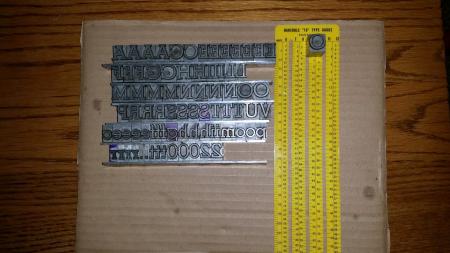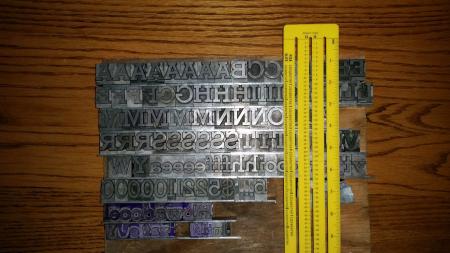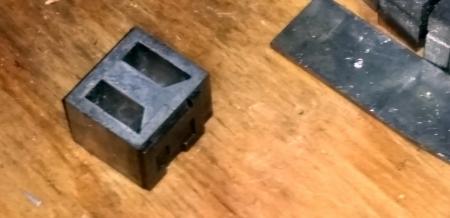type ID basics
My dad had these stored in newspaper dated 1971. He never did anything with them, they had not been touched since the day they were wrapped. I read in other posts there is a reference book for identifying
type. I can probably find it at the Pratt library - my son is a student there. How does one measure point size? Is this the right ruler? I also have a pica ruler. What kind of press would these be used on? Thanks for any guidance.

leadtypeone.jpg

leadtypetwo.jpg

typesideview.jpg
For the first part of your question - there are a great many older type specimens which can be used to identify type. One of the best ways I’ve learned is just to go trough the old posts on this message board, under the “Press and Typeface Identification” category. Others on this forum can usually identity type faces quickly based on the references they have on hand. Many type specimens are not readily available online.
Regarding the second part of your question. There are 12 points to a pica, 6 pica to the inch, therefore 72 points to the inch. The best way to measure type is by using a line gauge, since smaller point sizes (10 or 14 point) don’t work out to even pica measurements. But you can approximate from pica by multiplying by 12.
Line gauge - buy one here: http://order.nagraph.com/composing-room.html
That Type you have, has been cast on a Monotype Giant or Supercaster, makes looking for the Face easier, as it has to be one of the Monotype Faces.
By the way, one of the best resources is the Book of American Types which is a reprint of an the 1934 American Type Founders specimen.
http://www.amazon.com/Book-American-Types-Type-Founders/dp/0764327704/re...
Taking a look through my copy - lends me to think your type is Stymie Bold.
IMG_7025.jpg
If its Monotype (UK) the face is called Rockwell
Thank you everyone for all that information. So is there any value to all of this lead since it was meant to be melted and re-cast as needed? Are these interchangeable with letterpress letters? I’m guessing not, since mine are backwards and letterpress examples I’ve seen aren’t - or maybe I don’t understand the different printing processes?
Also: I’m pretty sure I can find a line gauge among my dad’s stuff (he was a commercial artist), but now I wonder what this ruler was used for? Here are better pictures:
haberuleback.jpg
haberulefront.jpg
These *are* letterpress type.
They have some value, not a ton, but more than they are worth as scrap.
Have a look on eBay and you’ll see what individual sets (founts) sell for. Compare sizes and number of sorts (letters) and you’ll get a good sense of the price.
The good news is that Rockwell/Stymie is a well-known and highly usable typeface, that means more buyers are interested.
Thank you, that is good news. I am looking to sell these. My knowledge of this is limited to what I learned at my part -time paste up job during college and exposure via my dad. Fascinating stuff.
Your Haberule is in points—6, 7, 8, 9, 10, 11, and 12. The 12 is also a pica so along the top, long edge is picas. The numbers under the 6, 8, etc are number of lines of type per inch. The Agate measurement means there are 14 lines of type per inch.
I think I get it. This would be used for measuring the number of lines per inch for each point size. I’m guessing it would be used by someone designing blocks of small size text. That makes sense. My dad worked on a lot of product packaging. Thank you. Too bad I didn’t think to ask him about all this before he died. I probably did once before, but without any real need to know or use the information, it went in one ear and out the other.